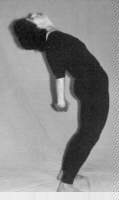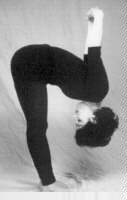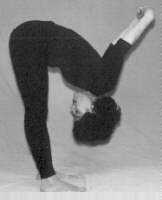|
Dwikonasana - The Double Angle Pose
|
by: Vasanthi Bhat and Rajiv Jaswa (vasanthi@vasanthayoga.com)
In today’s fast paced lifestyle, stress is becoming more and more of a
problem. It is damaging to your health and must be relieved.
There are various poses, or asanas, that can be used to relieve stress and revitalize your tired
body and mind. The Dwikonasna (dvee-kohn-ah-san), or the double angle
pose, is one of the easiest of these poses, and in addition has many healing powers. Within minutes, one can be revitalized,
flushing stress out of the body. This article will focus on both mental and physical benefits of the
double angle pose.Mental Benefits of Dwikonasna
Dwikonasna is one of many yogic poses in which the head is bent in a
downwards position. This allows better circulation towards the brain, creating many mental
benefits. The most important effect of this pose is its revitalizing effect. At almost anytime
during the day, you can practice this pose to refresh yourself, and release mental fatigue. This is
extremely useful when you are working long hours, and are mentally exhausted. People of all
ages can use this aspect of the pose, since stress is a factor in virtually everyone’s lives. In
addition, better circulation towards the brain improves concentration and memory. These two
effects are adirect result of the revitalization sensation. All of these benefits are important, and
can have a positive impact on everyone’s life.
Physical Benefits of Dwikonasna
Dwikonasna is a full body stretch that is used to stretch and strengthen almost every muscle in the body.
Beginning with the calves and hamstring, it also includes the hips. It also can be used to
alleviate lower back pain, as it stretches out the entire spinal chord. On the other side of your
body, the chest muscles are stretched out, and therefore, it can alleviate heart disease and lung ailments.
People suffering from high cholesterol levels can also use Dwikonasna, as it opens up coronary
arteries. The muscles located in the arms and joints in the wrists are massaged and stretched.
Hence, it can be used to alleviate carpal tunnel syndrome. The facial muscles are also
massaged, helping skin texture in that area as well as making it more radiant. As mentioned,
there are several benefits associated with this pose that can be achieved simply through
practicing this pose for a few minutes each day.
When you should practice the Dwikonasna
The Dwikonasna is a simple standing pose that can be practiced anywhere, whether it is during
an office break, or a short recess in between final exams. This pose can also be practiced, along
with other asnas, in the morning shortly after awakening. Those that exercise routinely or
practice sports can also use it before and after completing the activity to relax the muscles used
during the activity.
Technique

- Stand straight, with legs apart approximately half to one ft.
- Interlock your fingers behind your back, with your palms facing
upwards.
- Breathing in, stretch backwards as you hold your arms straight.

- Breathing out, bend forward as much as you can.
- Assume normal breathing in this position, stretching more if you feel
comfortable.
- Make sure to keep your knees locked. Bending legs at your knees
further, reduces stretch on the hemstrings and hips.

- Try not to strain and use force while stretching. Holding the pose
comfortably helps relax the muscles.
- For quick relaxation, stay in this position for 15 to 30 seconds.
- For relieving tension and to condition the body, repeat 2-3 times or stay
in this position longer.
To conclude, the Dwikonasna is a full body stretch with
both mental and physical benefits that can be achieved through consistent practice of this pose
using proper technique as mentioned above.



